 På norsk
På norsk
Article in the book Samisk skolehistorie 6 (Sami School History). Davvi Girji 2013.
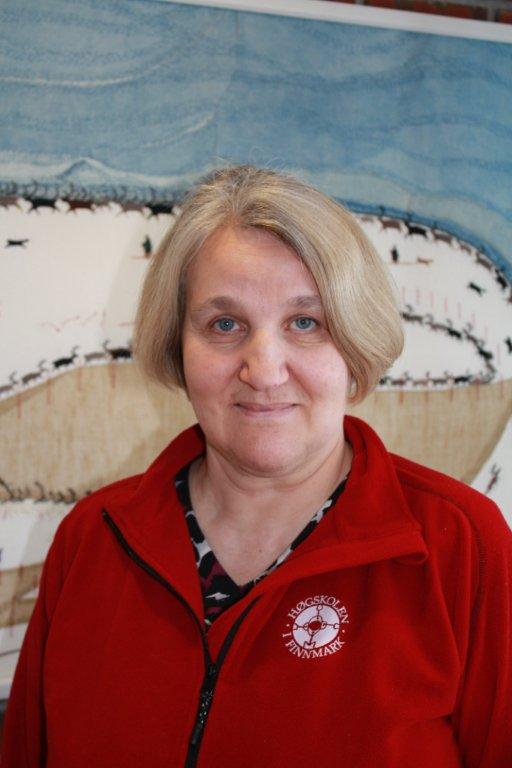 Randi Bratland
|
Randi Caspersen Bratland was born in 1953 and grew up in Lier in Buskerud county. She trained at the Menighetssøsterhjemmets sykepleieskole (nursing college), holds a teaching degree from the University of Oslo, majored in social policy and did a foundation course in social anthropology at the University of Tromsø. She is now senior lecturer in nursing education at the University College of Finnmark. Before coming to Finnmark, she worked at the former Aker Nursing College in Oslo and at the Thaeler Memorial Hospital in Nicaragua. This article was written in 2007. |
The task of nursing education is to respond to society's need for nurses, including minority needs. Thus, an important contribution to improving the situation for Sami patients is to train nurses who are bicultural and bilingual in Sami and Norwegian. But how can this be achieved? From 1995 to 2001 two sets of nursing students were trained in collaboration between the University College of Finnmark and Sami University College. In this article I will discuss my own experiences as a participatory researcher for a group of bicultural students.
The framework plans for nursing education do not include any special formulations regarding Sami conditions. This has been a particular challenge for the North Norwegian colleges, all of which have had contact with Sami patients in the health service. In such colleges, training about Sami patients has been included in the syllabus where appropriate and on the basis of the students' interests. Since the beginning of the 1980s, Sami-speaking students have been allocated quotas in Finnmark. The quota has been 10% of the number of students. The quota system has been justified in years when there was a high level of competition to enter nursing education, but in recent years it has not been especially competitive and the quota system no longer has any practical significance. Upon application, students with Sami as their first language have been given extended time for their exams.
In 1995 we started up with the first group of nursing students in Kautokeino. Applicants were required to have knowledge of the Northern Sami language. In practice, the requirement was not as stringent as for admissions to Sami University College. However, Norwegian was the written language used on the programme, partly because none of the teachers were able to correct coursework in Sami. The adverts for teaching posts stated that the teaching language would be Norwegian. Initially, it was university college teacher Nelly Stafne who moved to Kautokeino and taught the students. However, the University College of Finnmark managed to employ a Sami-speaking teacher, Berit Bongo. She took up her post after 3 months.
All ten students accepted onto the programme had obtained university and college admission certification, but several others were rejected as they lacked this. The group of Sami students received tuition both in Kautokeino and in Hammerfest. They were taught nursing theory separately but joined the rest of the class in some study areas. Berit Bongo supervised the students in both Kautokeino and Hammerfest.
In the practical parts of the nursing programme, the Sami students participated in the usual way. When they were practising in Sami areas, in addition to ordinary practice follow-up, they were offered a Sami-speaking tutor, Turid Ulvenes. In connection with training in aspects of Sami care, a field course was carried out in Kautokeino in the third year of the programme. This lasted two days. The course was connected with training in sociology and social anthropology, and I was in charge of the academic content. The curriculum included works by Eivind Bråstad Jensen (1991), Per Fugelli (1986) and Berit Bongo (1986). During the field course, the students visited a farm, a pensioners' club and other places in the local community searching for some background to the Sami patient.[1][1]
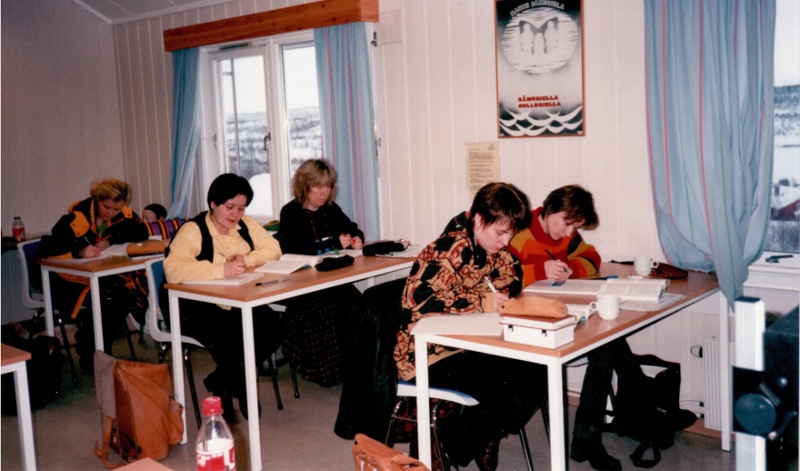 |
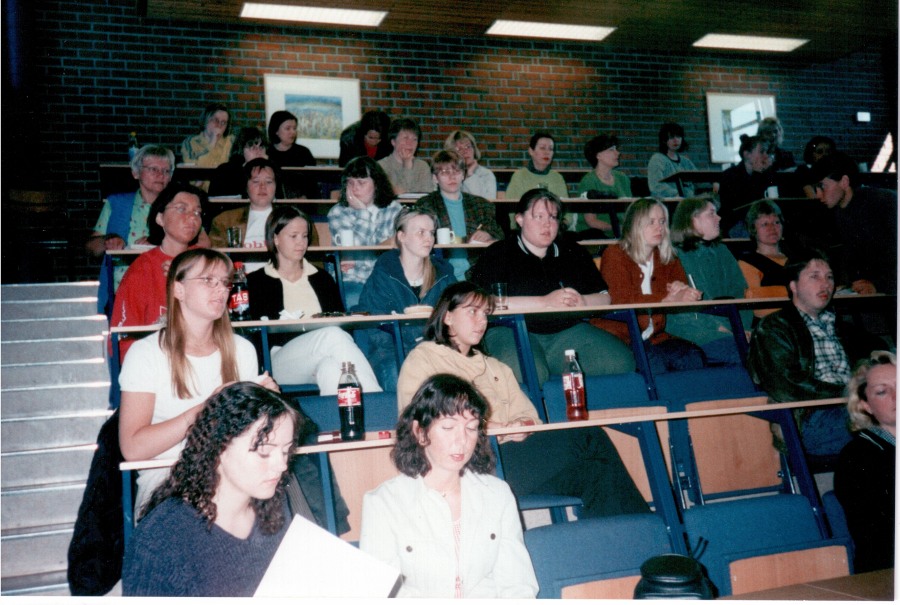 |
| Studies at Sami University College. From right: Inger Marit Eira (Åhren), Inga Sara, Solbjørg Valio, Berit Inger Anne Henriksen, Ellen Marit Gaup. (Photo courtesy of Solbjørg Valio) |
Training in the auditorium in Hammerfest together with students from Hammerfest. (Photo courtesy of Solbjørg Valio) |
I followed the class of 1995 in the first six months, and then I was absent due to maternity leave. I then followed the students for the remaining half year of their study programme. During my absence, it was my colleague Unni Bente Elde who collected data and visited the students in Kautokeino.
Below I will quote from the evaluation report to clarify both the opportunities and the challenges of this project. A brief meeting with the class viewed from my Norwegian perspective:
On 9 October 1995 I travelled together with one of the subject teachers to Kautokeino to make classroom observations of the small group at Sami University College. ... The everyday language at the college is Sami, but everyone easily transitions to Norwegian when they discover that the newcomer only speaks Norwegian. The classroom was small and narrow and was located on the second floor.
The lecturer was Norwegian. However, the students had already had other teachers from Kautokeino who had taught in Sami. I asked the students how they felt about the Sami language being used in training. One of the students replied: "When the teacher speaks Sami it is easier. I can write as I listen, since it is my first language that is being used – my ears get to relax»
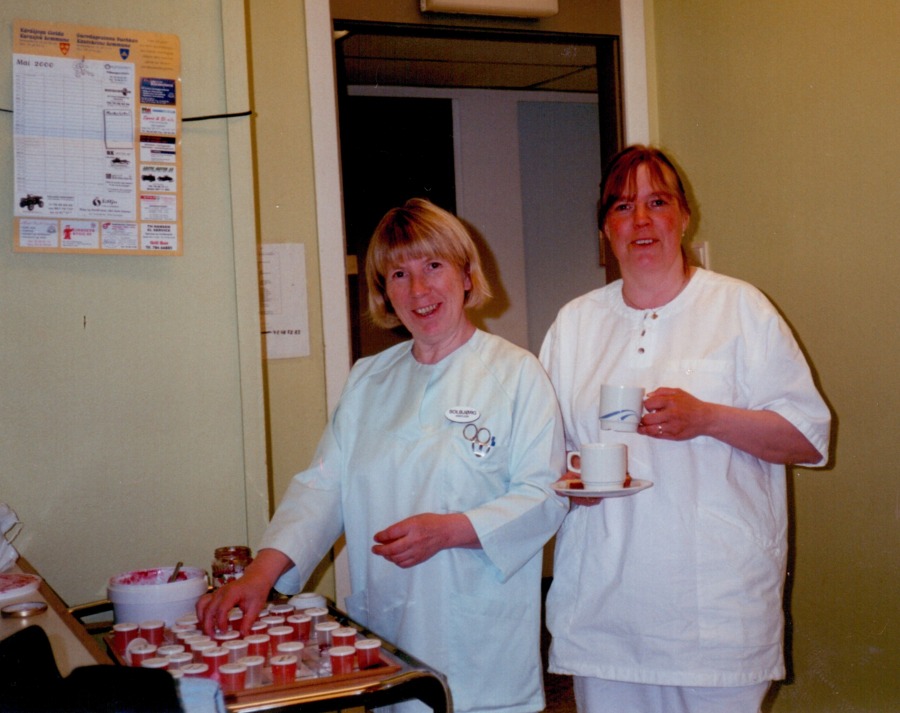 |
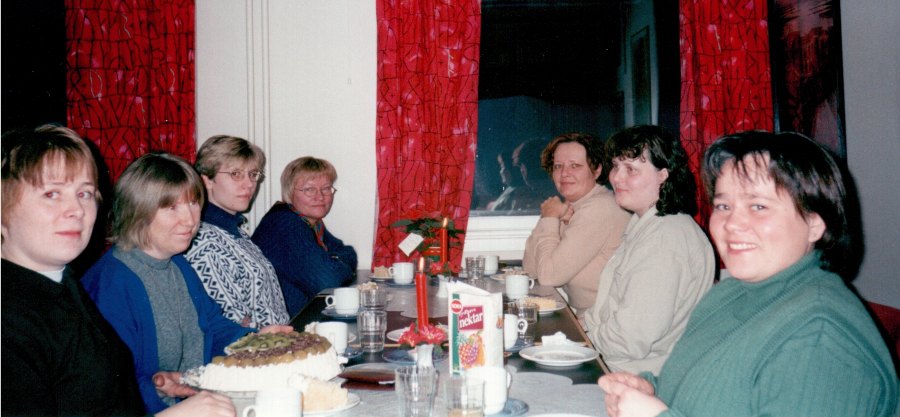 |
| Practising at the health centre in Kautokeino, nursing student Solbjørg Valio and nursing assistant Annbjørg Dorgli Hætta. (Photo courtesy of Solbjørg Valio) |
In the canteen at Sami University College From left: Anne Kirsten Anti, Solbjørg Valio, June Turi, Berit Bongo, Else Kvamme, Astrid Rasdal Kemi, Inga Sara. (Photo courtesy of Solbjørg Valio) |
Internally at the University College (Department of Health Education in Hammerfest) there were several people who reacted to the students speaking Sami in their lessons. I think this was to do with the primary intention of mitigating the shortage of nurses in Inner Finnmark and the fact that many people had not considered that this would lead to students speaking Sami in their lessons. The fact that the Regional University College Board had initially used the language regulations in the Sami Act as a basis, would appear to have been forgotten. The department's administration was more concerned about the geographical barriers and how these could be overcome via ICT. Sound and image studios were used in connection with the project – but the intention of extensive use of ICT was not realised due to poor equipment.
The next day the students were supposed to engage in project work. The work lasted the whole day and concluded with a presentation the following day. The students planned the projects in Sami and presented them in Norwegian. As a Norwegian speaker I was unaccustomed to observing Sami being spoken in the groups. The presentation was a pure revelation and was of good academic quality.
The use of the Sami language in the groups also put the role of researcher to the test. How could I evaluate something I didn't understand? I decided I would have to tolerate this for a period. The students had a Sami-speaking teacher, who could follow the students' discussions. For my part, I became even more clear about the significance of the Sami language to the students, and that this was more important than my being sidelined. After all, I gained an insight into the quality after a while. The students subsequently had to relate to Norwegian-speaking patients and colleagues in a Norwegian context, and they managed this very well.
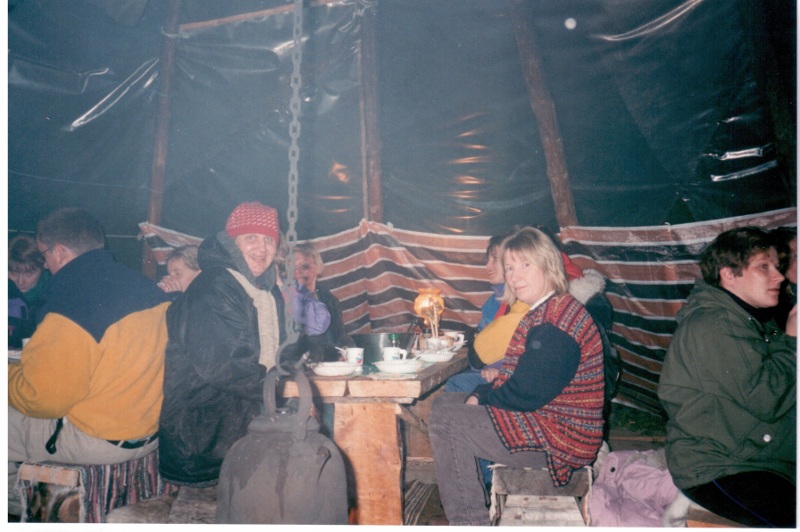 |
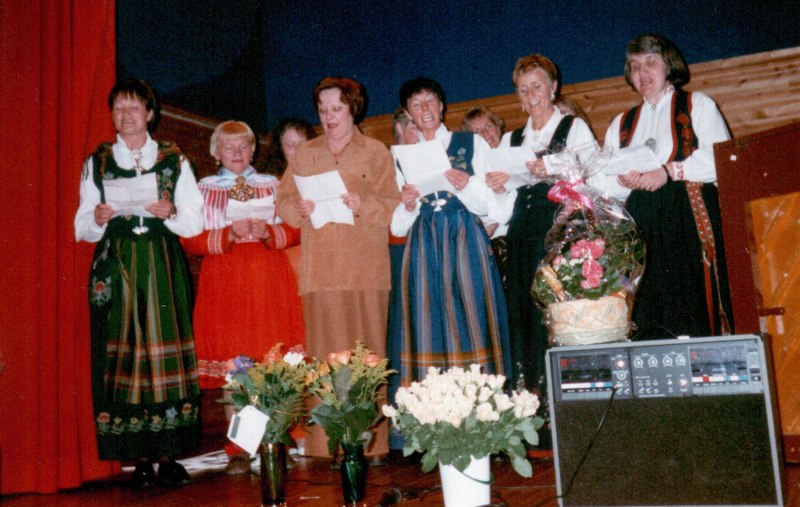 |
| When 30 students from Hammerfest visited Kautokeino, they were served biđus (reindeer stew) in a lavvo at Suohpatjávri. Pictured: Randi Bratland and students Solbjørg Valio and Ellen Marit Gaup. (Photo courtesy of Solbjørg Valio) |
Teachers at the graduation celebration in Hammerfest. From left: Petra Larsen Olsen, Berit Bongo, Else Kvamme, Gudrun Nilsen, Grete Mehus, Randi Bratland. (Photo courtesy of Solbjørg Valio) |
For those of us who are not bicultural, it is naturally difficult to perceive how it feels to be bicultural. I should therefore like to stress that this can be perceived differently by different people, and any attempts to explain this should be met with caution. ... Cultural adjustment can be perceived as a stressful situation, in which a person is constantly switching between cultures, between the known and the unknown – and where the factors described above (and others) play a part. The use of the first language plays a role in order for the situation to be perceived as safe and meaningful. In our experience, being bicultural in a vocational role liberates much creativity and makes study personal and relevant for the students. My own data has revealed that many of the students would not have enrolled in nursing education had it not been offered in their home town or at Sami University College. However, there are also other ways of doing this. Biculturalism is not an argument for every new municipality to have its own training programme. At the same time, it was challenging to study in a small group removed from the parent college in Hammerfest. Nursing students felt that there were few academic discussions with other students or staff at Sami University College. And it appeared as if what they appreciated more was going to Hammerfest towards the end of their training, even if there were some challenges in studying at two different university college campuses. In connection with the field course (Bratland, Bongo 1999) in social sciences, Kautokeino students were visited by students from Hammerfest (30 persons), something that all parties reported as a positive experience.
The encounter between Sami society and Norwegian nursing education was exciting to witness, and I was therefore disappointed that the project was not continued. The decentralised programme at Sami University College in Kautokeino was discontinued in 2001. There were multiple reasons for this: New guidelines for the organisation and implementation of distance learning programmes with state university colleges assuming academic responsibility (1996) meant that university colleges could not run permanent, decentralised programmes in one study location, these would have to be rotated. Moreover, this programme was established by the Regional University College Board at a time when the four university colleges in Finnmark, including Sami University College, had joint management. This was no longer the case after the university college reform of 1995. The university college system also entered a phase with more emphasis on efficiency and finance (NOU 1988: 28 With Knowledge and Will), and this influenced the management at the University College of Finnmark, who believed that there were insufficient potential student numbers in Kautokeino in order to continue.
When the programme was moved, the collaboration between the university colleges also ceased. New, decentralised programmes had the same focus as the foundation course in Hammerfest. In practice there were no Sami supervisors and no Sami-speaking participating teachers, and the Sami content was designed with the students' and the teachers' own interests in mind. The field course was continued and was sometimes used in municipalities affected by the Official Language Act.
It proved unfortunate to link the Sami language with a decentralised model because the term "decentralised" was vague in relation to the Sami content. Decentralised nursing education in Inner Finnmark was in reality the precursor to a Sami nursing education. When the programme was discontinued, much of the development work in relation to aspects of Sami care ceased. In 2008 a new decentralised programme was established in Porsanger municipality with support from the Sami Parliament. The curriculum states that the programme shall have a Sami profile, but there is still work to be done to determine what the Sami profile shall be based on, both theoretically and in practice.
In my opinion, the University College of Finnmark should, based on this background, be given a special responsibility for Sami care work and research into nursing.
Literature:
Bongo, Berit: Sykepleie som mellommenneskelig aspekt Sámi medica 3/1986
Bratland, Randi C / Bongo, Berit A.: Sykepleierutdanningen og den lokale utfordring. Evaluering av desentralisert sykepleierutdanning i Indre Finnmark fra 1995– 98. » HiF - Forskning 1999:11
Dobson, Susan M: Transcultural Nursing – a contemporary imperative Scutari Press, London 1991
Fellessekretariatet: Rammeplan for 3-årig grunnutdanning i sykepleie. August 1987. Ajourført 10/1-89
Fuggeli, Per: Skjulte helsebehov hos samer Sámi medica 3/1986
Hoëm, Anton: Tradisjonskunnskap og det samiske utdanningssystem. Foredrag holdt ved Urbefolkningskonferanse i Kautokeino 28.10.1996
Jensen, Eivind Bråstad: Fra fornorskningspolitikk mot kulturelt mangfold. Nordkalottforlaget 1991.
Kirke-, Utdannings- og Forskningsdepartementet: Nye retningslinjer for organisering og igangsetting av fjernundervisningsstudier med statlige høgskoler som faglig ansvarlig. 06.12.96
NOU 1988: 28 Med viten og vilje
NOU: 1995:6 Plan for helse- og sosialtjenester til den samiske befolkning i Norge.
Redfield, R, Linton, R and Herskovits: Memorandum on the study of acculturation. American Anthropologist 38, 149–152
Sameloven av 12. juni 1987. Samelovens språkregler.